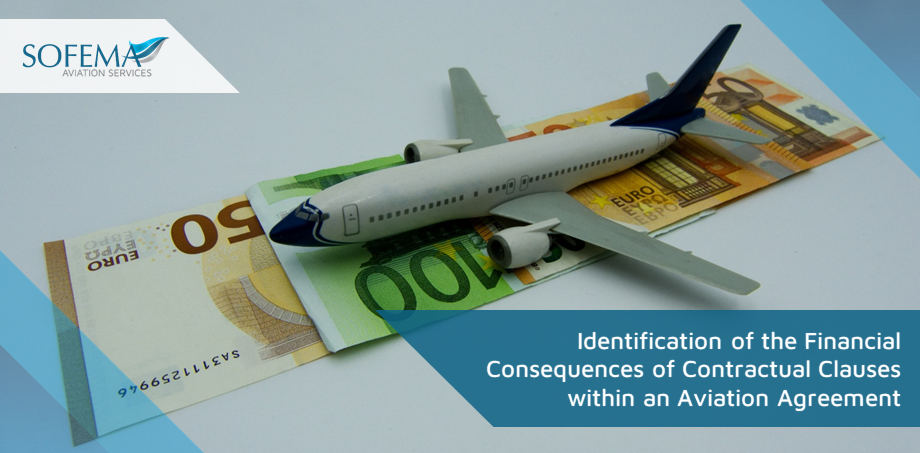Sofema Aviation Services (SAS) examines financial impacts of contractual clauses in aviation agreements.
Introduction
The financial consequences of contractual clauses within aviation agreements, such as Standard Ground Handling Agreements (SGHAs) and Maintenance Contracts, are significant and can directly impact operational costs and financial stability.
Ambiguities in key terms, particularly in liability, indemnification, and service scope clauses, often lead to disputes and unforeseen financial burdens. Failure to comply with Service Level Agreements (SLAs) can incur financial penalties, while disruptions caused by events like strikes or natural disasters (Force Majeure) remain financially challenging when cost allocation is inadequately addressed.
Additional risks arise from scope creep or unplanned services due to poorly defined Change Management processes, which can inflate costs, particularly during critical events such as Aircraft on Ground (AOG) scenarios. Improperly structured insurance and indemnity clauses can unfairly shift financial risks to one party, while a lack of performance monitoring, reviews, and audits weakens financial accountability.
Consider the following:
- Unclear terms in SGHAs or Maintenance Contracts (e.g., service scope, liability, or indemnification clauses) can lead to misinterpretation and disputes.
Example: Article 8 (Liability and Indemnity) in SGHA specifies shared liability, but ambiguous wording may leave room for disagreement. - Non-compliance with Service Level Agreements (SLAs) can lead to financial penalties and reputational damage.
- Contracts often lack clarity on cost allocation during disruptions (e.g., strikes or natural disasters) – Force Majeure.
- Changes or additional services during operations can inflate costs without clear Change Management clauses.
Example: Maintenance agreements lacking predefined hourly rates for AOG events may lead to unexpected expenses. - Improperly structured indemnity or insurance clauses may shift financial risks unfairly onto one party.
- Failure to implement regular reviews and audits weakens financial accountability.
Best Practices – Clear and Comprehensive Drafting
Clear and comprehensive drafting is essential for mitigating financial risks and ensuring the effectiveness of aviation agreements, particularly in Standard Ground Handling Agreements (SGHAs) and maintenance contracts.
Applying “Clarity and Precision” drafting principles ensures that contractual obligations, such as scope of services and payment expectations, are clearly communicated and legally enforceable. Incorporating Service Level Agreements (SLAs) with measurable performance metrics strengthens accountability.
Contracts should address unforeseen disruptions by including force majeure clauses with well-defined financial responsibility breakdowns. This ensures that both parties understand cost allocation during events like strikes or natural disasters, preventing disputes.
Robust indemnity terms are also vital to fairly distribute financial risks, protecting each party from excessive liabilities. Regular performance reviews and audits play a crucial role in tracking financial impacts, ensuring compliance with SLAs and SGHAs.
Consider the following:
- SGHA Article 6 (Remuneration) must explicitly outline payment terms, additional charges, and penalties for non-performance.
- Use “Clarity and Precision” drafting principles to avoid ambiguity in maintenance contracts.
- Incorporation of SLAs – Define measurable performance metrics (e.g., turnaround time, service quality benchmarks).
- Include penalty clauses for underperformance and incentives for exceeding targets.
- Add force majeure clauses with financial responsibility breakdowns to manage unforeseen disruptions.
- Implement detailed indemnity terms to allocate financial risks fairly.
- Establish processes for handling changes to service scope or operational needs to prevent unexpected cost escalations.
- Regular performance reviews to track financial impacts and enforce compliance with SLAs and SGHAs.
Key Issues to Take into Consideration
- Clarify financial responsibilities for:
- Delays or service failures (SGHA Article 8).
- Damage caused during operations (SGHA Annex B customization).
- Arbitration or litigation clauses (SGHA Article 9) can add substantial costs. Provisions must aim for efficient and amicable dispute resolution.
- Clearly define the Scope of Work (SoW) in both maintenance and operational contracts.
Example: SGHA Annex A details all services but needs negotiated customization to avoid scope-related disputes. - Insurance and Indemnification – Ensure sufficient insurance coverage for operational risks.
- Incorporate liability caps to limit financial exposures from catastrophic failures.
- Termination Financial Impacts – Address financial consequences of termination for cause or convenience.
Clarifying financial responsibilities is critical to mitigating risks and ensuring equitable cost management. Contracts should prioritize efficient and amicable dispute resolution methods to preserve relationships and avoid prolonged legal proceedings.
A well-defined Scope of Work (SoW) is equally important to prevent disagreements over responsibilities and services.
Provisions for termination, whether for cause or convenience, must also include clear financial consequences to protect both parties and outline obligations in the event of early contract termination.
Next Steps
Follow this link to our Library to find & download related documents for Free.
Sofema Aviation Services and Sofema Online provide classroom, webinar, and online training.
For further details, please visit our websites or email team@sassofia.com for comments or questions.
Tags:
SAS blogs, service level agreements (SLAs), Aircraft on Ground (AOG), maintenance contracts, financial penalties, financial consequences, Standard Ground Handling Agreements (SGHAs), Level Agreements (SLAs), SGHA Article 6 (Remuneration), Scope of Work (SoW)





